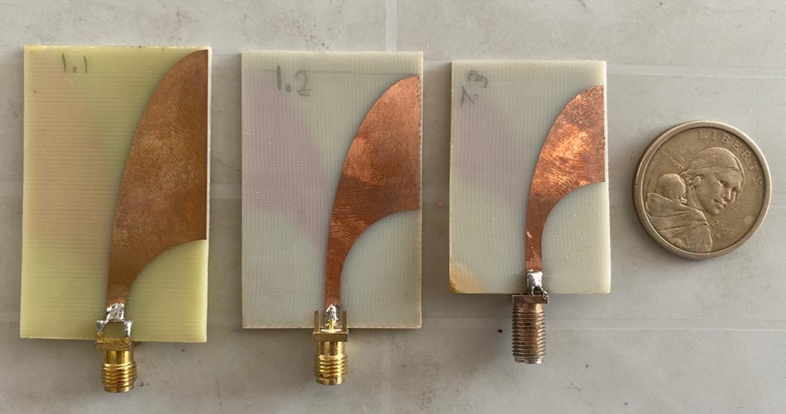Biometric System: Study of Radiation on the Human Arm
Main Article Content
Abstract
The study assessed radiation power absorption in the 1.5 to 5 GHz range for Wi-Fi, LTE, and AM modulation, using three Vivaldi antennas in an anechoic chamber with a phantom arm made of animal bone, ballistic gel, and pigskin. Wi-Fi showed the highest absorption levels, but these values (0.168 mW and 0.050 mW) were below ICNIRP safety limits, indicating no significant risk to human health.
Downloads
Article Details

This work is licensed under a Creative Commons Attribution 4.0 International License.
Authors who publish in this journal agree to the following terms: Authors retain the copyright and guarantee the journal the right to be the first publication of the work, as well as, licensed under a Creative Commons Attribution License that allows others share the work with an acknowledgment of the authorship of the work and the initial publication in this journal. Authors may separately establish additional agreements for the non-exclusive distribution of the version of the work published in the journal (for example, placing it in an institutional repository or publishing it in a book), with acknowledgment of its initial publication in this journal. Authors are allowed and encouraged to disseminate their work electronically (for example, in institutional repositories or on their own website) before and during the submission process, as it may lead to productive exchanges as well as further citation earliest and oldest of published works.
How to Cite
References
[1] S. Ullah, H. Higgins, B. Braem, et al., “A Comprehensive Survey of Wireless Body Area Networks,” Journal of Medical Systems, vol. 36, pp. 1065-1094, Aug. 2010.
[2] J. Salazar, Redes Inalámbricas, “Thesis, České vysoké učení technické v Praze, Fakulta elektrotechnická, Praha, Czech Republic, 2022. [Online]. Available: https://upcommons.upc.edu/bitstream/handle/2117/ 100918/LM01-R-ES.pdf.
[3] R. Sánchez, K. Buri, S. Sarango, C. Cabrera, “Avances tecnológicos y científicos en radiología,” Avances tecnológicos y científicos en radiología. RECIAMUC, vol. 7, pp. 457-465, Abr. 2023.
[4] J. P. Michelino, ”Performance de IEEE 802.15.6 en coexisten- cia con IEEE 802.15.4 e IEEE 802.11,”Thesis, Universidad Nacional de La Plata, Facultad de Informática, December 2020.
[5] S. Ullah, M. Mohaisen, M. A. Alnuem, “A review of IEEE 802.15.6 MAC, PHY, and security specifications,” International Journal of Dis- tributed Sensor Networks, pp. 1-12, Apr. 2013.
[6] International Commission on Non-Ionizing Radiation Protection (IC- NIRP), “ICNIRP Guidelines for Limiting Exposure to Electromagne- tic Fields (100 kHz to 300 GHz),” 2020. [Online]. Available: https:// www.icnirp.org/cms/upload/publications/ICNIRPrfgdl2020.pdf. [Accessed: 26-Jul-2024].
[7] International Commission on Non-Ionizing Radiation Protection (IC- NIRP), “Specific Absorption Rate (SAR),” [Online]. Available: https://www.icnirp.org/en/frequencies/sar.html.[Accessed:26-Jul-2024].
[8] D. M. Andrade Guerrero y C. F. Contreras Ortiz, “Medición y análisis del nivel de exposición a radiaciones no ionizantes (RNI) en ambientes indoor en la ciudad de Cuenca, dentro del espectro radioeléctrico en la banda de frecuencia de telefonía celular,” Tesis de la Universidad Po- litécnica Salesiana, Cuenca, Ecuador, 2014.
[9] IT’IS Foundation, “Tissue Properties Database,” [Online]. Available: https://itis.swiss/virtual-population/tissue-properties/database/. [Accessed: 26-Jul-2024].
[10] IT’IS Foundation, Çustomized Research: Tissue Models Database,”[Online]. Available: https://itis.swiss/customized-research/ tissue-models-database/. [Accessed: 26-Jul-2024].
[11] S. Pardo Alia, “Control del brazo robot irb120 mediante el dispositivo háptico phantom,” 2016. [Online]. Available: https://ebuah.uah.es/ dspace/handle/10017/26467.
[12] E. Peréz, “Enlace de Comunicación,” May. 2023. [Online]. Available: https://repositorio.unbosque.edu.co/server/api/core/bitstreams/ea76f11b-7dfe-498b-9d48-9d6b7398e0a2/content. [Accessed: Apr. 19, 2024].
[13] J. Pipa,”Google Scholar,”2019. [Online]. Available: https://gc. scalahed.com/recursos/files/r161r/w25923w/S5R1.pdf. [Accessed: Apr. 19, 2024].
[14] E. Peréz, “Antena implantable a 2.45 GHz para telemetría biomédica implementada al interior de liquidos equivalentes de tejido (musculo, grasa y piel) y/o geles de imitación (phantom), Universidad el Bosque, Facultad de Ingeniería, May. 2023.
[15] N. Palomar, “Diseño de antenas UWB directivas y tamaño compacto para aplicaciones médicas operando en el entorno corporal,” Jul. 2019. [Online]. Available:https://1library.co/document/
[16] A. Calderón, L. Arce y R. Mejías, “Control de calidad de imagen y dosimetría, para mamografía digital, utilizando el fantoma Normi Mam Digital,” Uniciencia, vol. 32, no.2, pp. 70-81, Dec. 2018.
[17] F. Chinchurreta and R. Shaporin, “Fantomas y símiles de tejidos para aplicaciones biomédicas, [Online]. Available: https://www.itefi.csic.es/es/daend/ulab/fantomas-y-similes-de-tejidos-para-aplicaciones-biomedicas. [Accessed: Apr. 19, 2024].
[18] L. Pérez, “Anatomía evolutiva de brazo y el antebrazo en los ho- mininos, Tesis Universidad Complutense de Madrid, 2017.
[19] “Las personas pasan conectadas más de un cuarto del día,” Ecuador Verifica, Jun. 2, 2022. Available: https://ecuadorverifica.org/2022/06/ 02/las-personas-pasan-conectadas-mas-de-un-cuarto-del-dia/. [Acces- sed: Jul. 26, 2024].

